The main idea of robotics and eight smaller ideas

Not sure what to do on the weekend? Ball robots extended until July 20!
In the last post about the ball of robots sounded a lot of criticism of the exhibition. Like, robots are all squalid, clumsy and made "on the knee." Well, this is how to look. This is an exhibition of prototypes, each of which is a garage implementation of some idea. Behind a pile of gears and microcircuits it is not always visible for what a robot is made, but it was the idea that became the main factor in the selection of robots for the exhibition. Why not write about it?
')
Read the post. And, perhaps, you will go to the exhibition with a different look.

The Vitruvian Man is a drawing created by Leonardo da Vinci around 1490 as an illustration for a book dedicated to the works of Vitruvius . His treatise " Ten books on architecture " is the only remaining ancient work on architecture and it is based on our entire civilization. For any robotics, Vitruvius should be a reference book.
The main idea of the book is known to everyone, it says that "Man is the measure of all things." The whole architecture of the planet is based on the proportions of man. All engineering structures are made for people. Everything around us is created for human use and, of course, robots will copy it completely.
Such anthropomorphic robots have probably already been created and are located in secret laboratories, underground factories, military bases and the homes of insane scientists. And we have to be content with our imagination. The exhibition presents 40 robots, each of which implements only a few functions of a mechanical person. But all together - they are a full-fledged copy of a living person. The task of the exhibition is to combine these parts into a single whole with the help of your imagination.
That is why, next to each robot there is an indication of which part of the body of the “android” it represents, whether it thinks for itself - or is controlled by the operator.
And since fantasy works best in children, you can find the indicated age, which the robot is designed for.
Well and the main thing - about each robot the small history is written, where, among other things, it is noted where it came from.
1. Robot Tespian
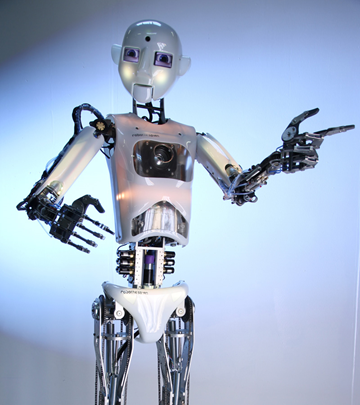
The robot "Tespian" ( RoboThespian ) is an interactive robot-android, loving and able to communicate with people. He was born in the most futuristic place in England, under the dome of the “Eden Project” in Cornwall.

Here he was assembled in 2005 to participate in the experimental theater of robots, Tespiana was made as interactive as possible, and he immediately fell in love with the public. 10 years later, the robot Tespian from Engineered Arts Ltd., together with Angela Merkel and David Cameron, opened the CeBit 2014 exhibition in Hannover in March of this year.
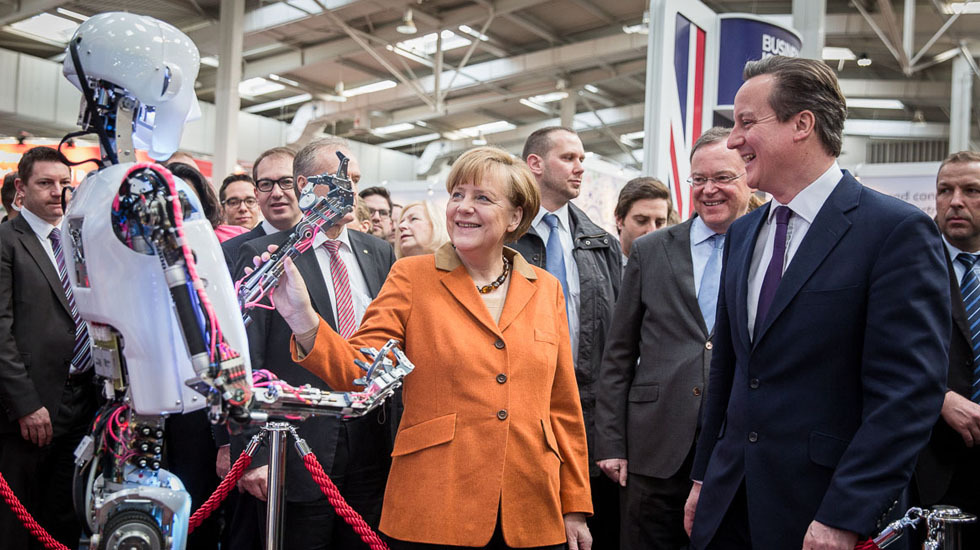
Tespian can change facial expressions of the face and voice, greet guests, recognize people, repeat their movements, determine the gender and mood of the interlocutor, tell stories, read poems, show presentations and play like a real actor. Tespian can be programmed for any creative and educational activity.
The robot is controlled from the terminal: the operator exercises direct control, including remotely. But the robot itself is able to interact with people: talk in English, turn to people and parody them. Tespian can repeat a phrase after you, answer a simple mathematical question, define a word, request a pose or even memorize a new phrase. And he also succeeds in doing scenes from movies.
But all this is only a set of pre-recorded programs launched by the operator. Tespian himself does not think that makes him the perfect actor or servant.
There is no doubt that the first generations of home robots will have similar intelligence - only a set of programs. This is more than enough to clean the apartment, go shopping or do the lessons for you.
But things are jokes, and such robots may soon begin to pose a serious threat to live actors - unlike a person who is only available with a certain set of characters, the robots on the stage are able to cover the whole range of assigned role-playing tasks.
To imagine the future of the entertainment industry, it is enough to recall the fate of a silent movie.
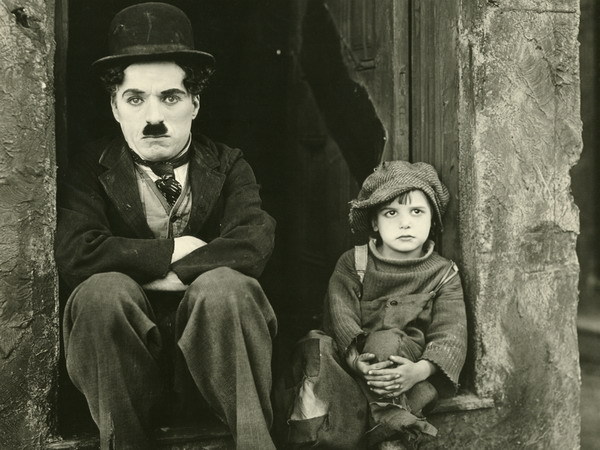
Then in France reigned Russian actors who fled from the revolution. Of course, they were superprofessionals, and the level of acting in silent films was significantly superior to modern, Actors of those years did just incredible things - for example, they conveyed the drama and content of the scenes only with facial expressions. It is the same as playing Eugene Onegin with a troupe of 20 memes.
With 20 tespians it is even easier than with live actors, they also highlight the emotions with lights.
Of course, now the robot is a prototype with gears out, but this gives it a certain charm inherent in all “garage prototypes”. Suffice it to recall what the first personal computer looked like - Steve Jobs and Wozniak assembled it in their garage in a wooden case!

And the first laptop in general was placed in a shabby diplomat - then the public laughed at the novelties of technology, but now, the descendants of these lovely “freaks” are in every house. So draw conclusions.

 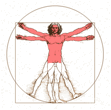    |
2. A2D2
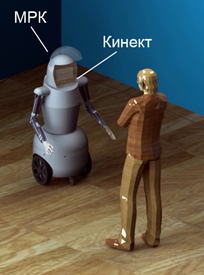
Statistic shows that the installation of surveillance cameras hundreds of times reduces crime and hooliganism. No one watches live in the field of view of the camera.
At best, there is one operator on nine screens. The rest of the cameras are either recording, or worse, they are models. However, this is enough - when a person knows that he is in the frame, he always behaves prudently.
However, the cameras are still, they are easy to get around, and they will not make comments to you.
And what if you put the camera on a mobile platform, provide a display and manipulators? Then it will be possible to “interact with the audience” manually, sitting in a different place behind your ipad.
At school, for example, the children of the robot and listen more.

Well, what about the main advantage of cameras - autonomy?
So with the robot is even better! No one will know when the operator controls him, and when he acts autonomously, all you have to do is put the Kinect sensor and write the recognition of faces, emotions and gestures. Then you can quite successfully simulate the presence of the operator and even change his mood as needed.
A2D2 security robot is a school telepresence robot guard. That is, it will be remotely controlled by a person.
Its peculiarity is that it can perform autonomous monitoring of the premises, and the person managing it can be located in any country of the world. In addition to other "chips" programs can read, that is, independently determine the emotions of people.
A2D2 is a mobile remote-controlled robot. The display is built in his head, which shows the image of the operator.
He also sees the interlocutor, can rotate the head of the robot in two planes, move the manipulators (they have five degrees of mobility) - for example, point somewhere, express their emotions with a gesture, or even embrace the person with whom he is talking. The robot moves with a maximum speed of 5 km / h and on a flat floor has high maneuverability. The mobile platform at the heart of the A2D2 is equipped with eight sensors that help the robot not to collide with surrounding objects. The robot is able to act without control: to recognize and repeat emotions using the built-in Kinect, to independently conduct a dialogue and go through the mazes. A2D2 can be connected to a power outlet, and the built-in battery will provide 4-6 hours of battery life.
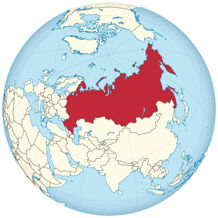 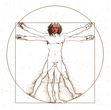  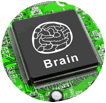  |
3. Alice
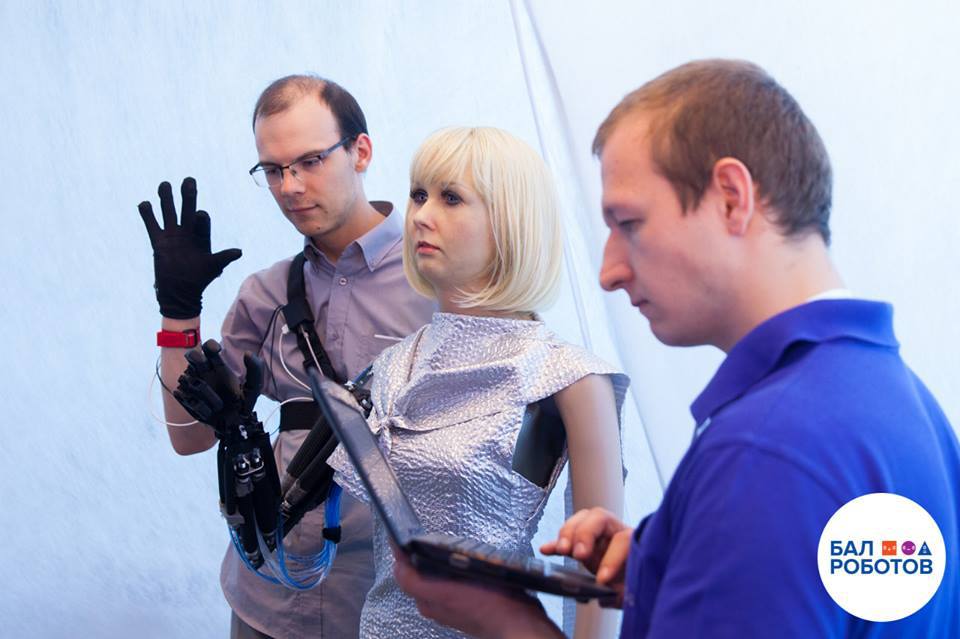
Human and apes are sharply distinguished not only by outstanding intellect, but also by the structure of hands. Man's hands are the crown of evolution, just like his mind. This is a complex engineering device, perhaps, unparalleled in the animal world. With our palm, you can paddle like a paddle, put it into a fist and beat it like a stone, or you can thread a needle or read Brael's alphabet by touch. The hand is adorable, and is rightfully the symbol of a person’s physical perfection.
Fist - the same primary and strong character, like the skull. Actually, man consists of these two parts, the rest is the standard “chassis” for all hominids.
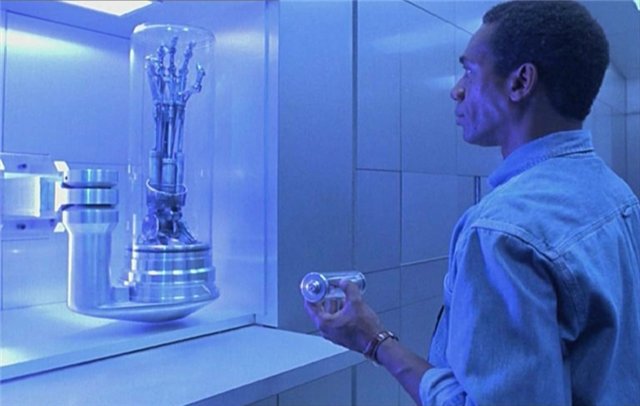
Remember the "Terminator 2" - in it the whole image of a killer robot is built on a mechanical arm (only she then remained with him with a piece of processor). He demonstrates the same hand to a fanatical scientist.
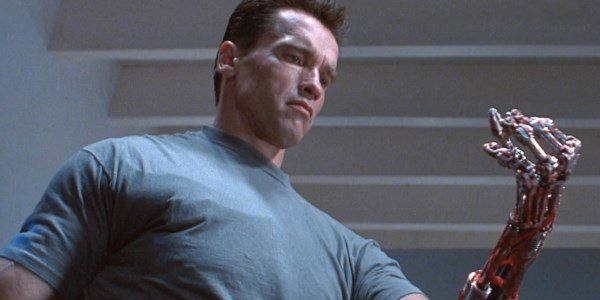
In 1991, this seemed to be the supreme proof of the excellence of the science of the future — a six-core processor and a hand repeating the human Really, a serious achievement for 1991. But, as you can see, today such hands can be assembled in the Zelenograd garage.
Alice's hand is built on soft pneumatics from parts created on a 3D printer. The design repeats the human and has all its degrees of freedom. That is, if it were made of steel, it would have to be lowered into molten metal in order to prevent scientists from creating skynets!

In addition to the hand, Alice has a face with 13 facial muscles. Thanks to speech recognition and elements of artificial intelligence, “Alice” can conduct a dialogue with a person, at the same time, she reacts to his emotions and is able to repeat them. Also a prototype, but allowing to reflect a sufficient palette of all basic human emotions and to demonstrate the possibility of making copies of the faces of real people.
These two technologies demonstrate the company's ability to create and fully human-like robot. They have already created the two most difficult components with one 3D printer and a dozen students from the Bauman.
 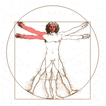    |
4. Pushkin

If we had the opportunity to resurrect the great people of the past, we would, of course, start with the best representatives of art. It would be nice to listen to Socrates' dialogues in the original version or discuss quantum physics with Einstein. But who resurrect first? Whose voice to return from the darkness of ages?

If Socrates was the founder of philosophy, then who “started” the Russian language?
I mean the modern, literary Russian, created by the government by the very end of the 18th century (before this Russian literary language simply did not exist, remember how Peter1 and his contemporaries wrote).
What is the difference between Pushkin and the writers of an earlier era? Karamzin completed the formation of the Russian language, and for the first time Pushkin spoke it, with all the modulations and turns. Pushkin's speech is our speech. There are still archisms and gallicisms, but in the general flow this is not noticeable. We are all Pushkins, this is our culture. To speak Russian even with Derzhavin is a problem. I think most of all, it will be like a conversation with a Serb or self-taught person who has learned Russian.
Pushkin was the first person to speak in literary Russian, and his speech was like the rumble of thunder - the great Russian literature was born. That is why Neurobotics chose Alexander Sergeevich as a prototype for its first robot.

Imagine that the same physics lessons will be able to lead Einstein, chemistry - Mendeleev, that Peter the First will tell you how he decided to build St. Petersburg or how to cut beards to boyars. Such lessons will be remembered forever.
The head of an anthropomorphic robot with a standard mount includes everything you need to see and hear, open your mouth and express emotions, follow a person's eyes, sing and read poems, maintain a dialogue with the interlocutor. True, to modulate speech, the usual function of its recognition by the Google search engine is used. The head of "Pushkin" can be docked with other modules: torso, arms and mobile platform, but can be used separately. Like Professor Dowell's head.

     |
5. R.BOT

Communication emulators, augmented reality, maps and guides - quite a promising genre of applications for tablets, like video calls. But they will always miss the “body” for complete independence. It’s one thing to carry an audioguide in your hand and, quite another, to follow the gallery in the wake of a real guide able to maintain a dialogue with you.
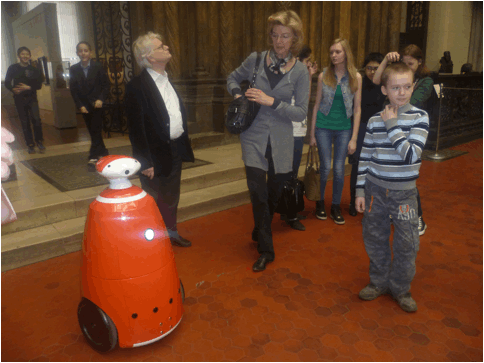
That is exactly what they decided at the Pushkin Museum of Fine Arts and launched a “digital guide”. The truth is not offline - it is controlled by the remote operator Anton. Anton does not have the ability to move independently, - he moves with the help of a wheelchair. He learned about the R.bot robot through the organizers of the Foto CHE charity project and volunteered to assist in conducting virtual excursions and master classes in photography.
This happens as follows: from his personal computer, right from home, Anton connects to the robot via the Internet and is completely transferred to the place where R.bot is installed. The speakers of the robot become Anton’s ears, the camera’s eyes, and the microphone transmits either what Anton says or the text he types on the keyboard. The movement of the robot and the turns of its head are controlled by the buttons on the keyboard. By the way, his “neck” mechanism has 4 degrees of freedom, which allows him to turn his head in 4 planes, that is, in all the directions necessary for a full view. Thus, the robot completely transfers Anton to the museum, allowing him to sense his presence there and communicate interactively.
Besides the fact that Anton has the opportunity to visit the museum without leaving home, he also helps other people who connect to the robot, see the museum’s exhibits, take a tour and chat with visitors.

Model Synergy Swan is a mobile chassis, which is attached to a smartphone running Android. This robot got the name “Swan” for a reason: when its neck unfolds or stretches out, it really begins to resemble a swan. You can control the robot and see the picture from the camera of the smartphone using the client application for any operating system, including mobile ones.
R.BOT Synergy Mime - a series of very small robots. Functionally, they are similar to Swan, but do not have wheels. But these robots are tiny and serve as a stand and charging for a mobile phone. The operator of such a robot can raise and lower the phone and twist Mime around its axis to see what is happening around.
     |
6. Paul

Thunderstorm all Arbat artists!
This robot will draw a portrait of a man in twenty minutes. To do this, he will need to see the face through the camera, then apply a unique algorithm to the image, which will turn the photo into a work of robotic art.

You, for certain, remember the similar device from film Bladerunner. Only there it scanned the emotional response and revealed the soulless androids. Well, our apparatus reveals the artistic value of a human face no worse, turning it into a work of art - in forty years this portrait will cost like a whole robot. Something like a portrait of a famous artist of the early twentieth century.
Draws "Pavel" taking an ordinary ballpoint pen in his hand. Do not miss the opportunity to get your portrait from the hands of the robot - yet a unique thing, if not cool. And we can hope that someday, Paul will be able to wipe on a large format. Extremely labor-intensive and large-scale work - in Russia only one person draws in a similar style, and he does not do it quickly. A robot could "print" any canvases without any tension.
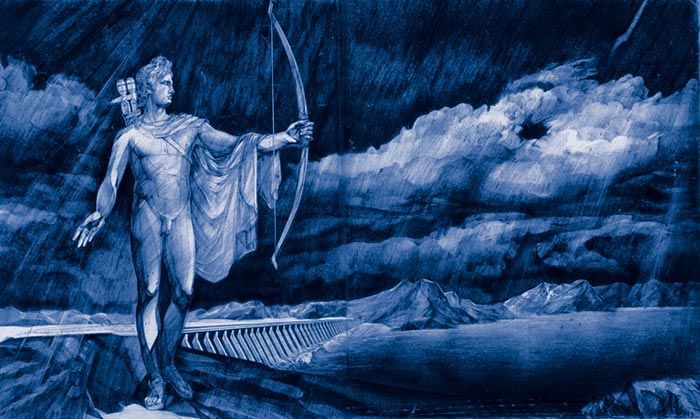
This picture “Novonovosibirsk” 4x2 meters is also drawn with a ballpoint pen, but by a man - Russian artist Alexei Gintovt
The creator of the robot is Patrick Tresse , a French artist and programmer. His goal was to give the machine the ability to not just mechanically reproduce the image. "Paul" draws as if the man worked on the picture. The algorithm incorporated in the robot is based on the modeling of human perception and hand movements of the artist.
     |
7. Pinokio
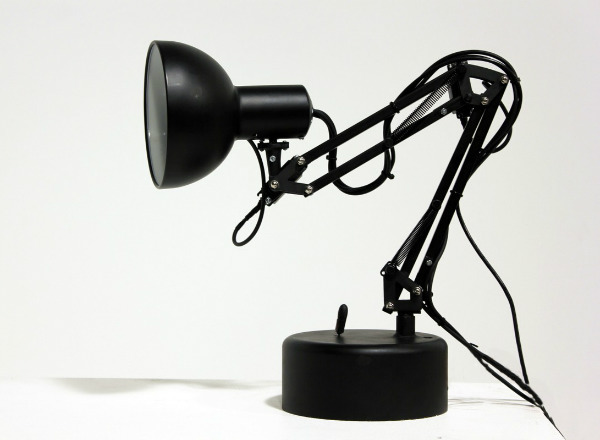
This lamp as a living , it recognizes the face and behaves depending on their expression - can flirt or, conversely, turn away. And if you try to turn it off - it will switch the toggle switch back, as if nothing had happened. Actually, the embodiment of the fairy-tale idea of revived furniture is in itself an art at the Disney level.

But the Pinocchio lamp goes further and creates a “intercultural phenomenon” - after all, the attitude towards things in Russian and European cultures is quite different.
Russian and German attitude to things: for Western culture, the thing is the victorious roar of war pipes, the power of the world, a symbol of its possession. For the Russian, a thing is a mistake, something not alive, but not dead, and therefore miserable. Things are the plagues of the world. The pre-revolutionary philosopher, Vasily Rozanov, was the only one, relatively clearly, who expressed this primary and therefore elusive feeling:
“It is sad for me that everything is imperfect: but not in the sense that things do not fulfill some commandments, some expectations from them (and does not come to mind), but that things themselves are somehow not good, they are not satisfied it hurts them. That things hurt, this is my constant suffering throughout my life. Through this pain passes tenderness. Things seem offended to me, some kind of orphans, someone loves them a little, someone appreciates them a little. There is something impoverished and sinister at the same time ... "
It is this uncharted cultural sector that the creator of the robot, Adam Ben-Dror, explores. As part of this project, he tried to explore the possibility of “reviving” an inanimate object and making it as expressive and responsive as possible. It turned out strange. On the one hand, the lamp is pitiful - it is so lively and will stand on the table.And on the other hand, the lamp is so cute and charming that the heart is breaking and I want to carry it with me and put it on my desktop.

That is why the PIXAR screensaver causes such contradictory feelings - it is simply not designed for viewers from Russian culture. We have a revived thing is something touching, sweet, but at the same time - tragic, in need of our care and protection.
The revived thing in Russia is Mitten, that's where all the primary and deepest attitude of our culture to things is expressed:

 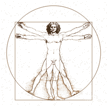    |
8. Baxter

As you know, biology puts one of the key distinguishing features - the way of nutrition. The structure of the jaws and the shape of the teeth can tell a lot about the diet and behavior of the animal. The same classification method applies to humans.
All human cultures come from diet. Literally! For example, what is the difference between Asians and Indo-Indians? In the same, what is the difference between rice and wheat. For example, growing European bread is a job for the lazy. Bread grows by itself, without needing special care or watering. Plowing is relatively easy - two months a year. Sowing bread is a simple scattering of seeds. The use of yeast allows you to nourish literally a handful of grains. The daily rate for living is two tablespoons of flour. On two spoons you can live a long time.
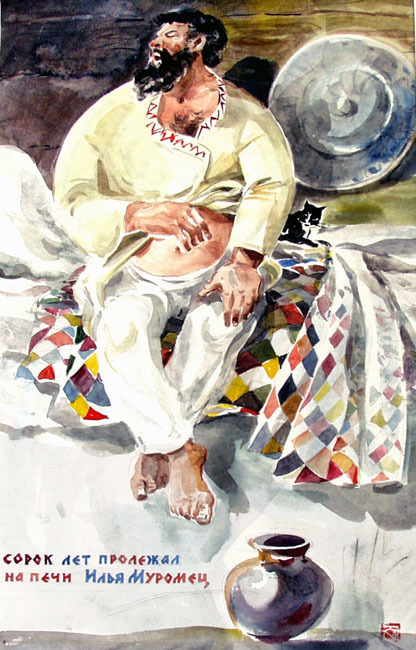
That is, the peasants with such a production cycle have a lot of free time. But a lot of free time only predators. Herbivores are always in business. They jurate and digest food. Digesting bread, as well as producing, is also easy. Bread nourishing, it is not sweet potatoes, which need to fill the intestines until it stops. The paradox is that bread is “vegetable meat”, and rotated with minimal effort.
The culture of bread itself stimulates intellectual activity, because a person has a lot of free time. Not for individuals, but for the whole mass.
Complaints about the backwardness of rural labor occur when subsistence farming is destroyed and there is a desire to collect an excess amount of bread. This peasants are extremely annoying, because long-term physical labor is unusual for them. The creeps and moans begin, greatly exaggerating the agricultural production. A laborer is equated with a hard labor worker, which of course is not true. The servile house voluntarily, - the farm-man works for a fee, the general mood of the farm laborer is cheerful. This is "shabashniki." Well, etc.

Another thing is rice. It requires monotonous and daily hard work. Every day we have to weed him, bent over in three deaths. At the same time, not only diligence, but also intelligence develops - the fact is that rice harvest is mathematically precisely related to the amount of labor invested - how much fertilizer you added, how much water you poured - how many grains you will collect. Here every peasant thinks like a professor of mathematics or a wolf on a hunt.
As a result, Asians and Europeans, formed in many respects opposing cultures. At the same time, Asians are generally smarter, more diligent and pedantic - just look at the progress of Chinese students in mathematics. In American universities, white fades on their background. But wheat gives an important advantage - due to the mass of free time, Europeans are much stronger in dialectics and therefore - the invention of the new. As a result, by the beginning of the 21st century, we came to a bipolar world in which Europeans design iPhones, Chinese assemble, and Americans sell.

That was before the creation of Baxter- It is designed to free millions of Chinese workers from assembly-line assembly. His two hands are completely human, and he is very easy to train. Already in 2014, he plans to replace 300,000 workers on the assembly lines of the Foxxcon company for the assembly of iPhones. If the experiment is successful, the bill will go to millions. After all, the robot has one absolute trump card. It takes 16 years to put a person on the assembly line, and robots can leave the assembly line at least every minute. Today there are 300 thousand of them - tomorrow 300 million. Who knows, maybe your iPhone was collected by Baxter?
The Baxter Intelligent Industrial Robot is the first of a family of devices that will work in factories and perform simple production tasks that previously required human presence. The difference between “Baxter” and a typical industrial robot is that it can be reprogrammed for a new action in just a few minutes. It is enough to indicate to him what movements need to be made, and then, if necessary, to adjust the program. “Baxter” does not work blindly: it recognizes objects around it, and if it notices that something has gone wrong, it will immediately stop work and call for help from a person. Baxter was developed by Rethink Robotics in 2012, and since then, has managed to become famous throughout the world.
     |
Well, eight robots enough for today? Continued on Monday, and on weekends - come to get acquainted .
Source: https://habr.com/ru/post/228635/
All Articles